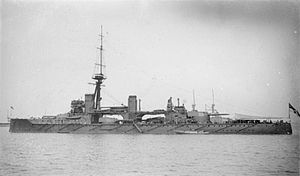 Colossus at anchor, shortly after completion
| |
| Class overview | |
|---|---|
| Name | Colossus-class battleship |
| Operators | |
| Preceded by | HMS Neptune |
| Succeeded by | Orion class |
| Built | 1909–1911 |
| In commission | 1911–1921 |
| Completed | 2 |
| Scrapped | 2 |
| General characteristics (as built) | |
| Type | Dreadnought battleship |
| Displacement | 20,030 long tons (20,350 t) (normal) |
| Length | 545 ft 9 in (166.3 m) (o/a) |
| Beam | 85 feet 2 inches (26.0 m) or 86 feet 8 inches (26.4 m) |
| Draught | 27 ft (8.2 m) |
| Installed power |
|
| Propulsion | 4 × shafts; 2 × steam turbine sets |
| Speed | 21 knots (39 km/h; 24 mph) |
| Range | 6,680 nmi (12,370 km; 7,690 mi) at 10 knots (19 km/h; 12 mph) |
| Complement | 751–791 (1916) |
| Armament |
|
| Armour | |
The Colossus-class battleships were a pair of dreadnought battleships built for the Royal Navy (RN) at the end of the first decade of the 20th century, the last 12-inch-gunned (305 mm) battleships built for the RN. The sister ships spent their whole careers assigned to the Home and Grand Fleets, often serving as flagships. Aside from participating in the Battle of Jutland in May 1916, and the inconclusive action of 19 August several months later, their service during the First World War generally consisted of routine patrols and training in the North Sea.
The Colossus class were deemed obsolete by the end of the war in 1918 and were reduced to reserve the following year. Hercules was sold for scrap in 1921, although Colossus was briefly used as a training ship. She was hulked in 1923 and sold for scrap five years later.